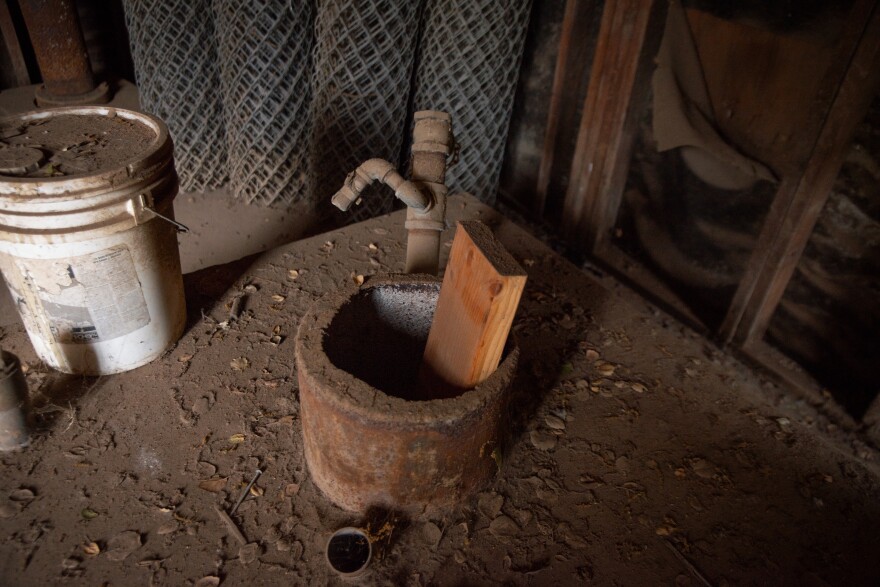This is part one of a three-part series supported by the USC Annenberg Center for Health Journalism’s 2025 California Health Equity Fellowship. Find part two here and part three here.
On a sunny day next to a Salinas Valley produce field, Drew McCown fills up two small bottles of water from a well.
“I've sampled about 400 wells this season,” he says.
He’s a project manager at Monterey Bay Analytical Services. The samples will be tested for nitrates, which come from fertilizers and waste, and other contaminants.
Every well on a Central Coast farm gets sampled each year. There’s about 5,000 of them according to Sarah Lopez, who directs the nonprofit Central Coast Water Quality Preservation, Inc. They oversee the process.
As she points to a map of Central Coast wells, Lopez says finding high levels of nitrates isn’t unusual.
“This long finger here is the Salinas Valley. It's basically the Salinas Valley floor,” she says. "And so you can see that there's a lot of red in there, so a lot more exceedances of the drinking water standard.”
It’s mostly from fertilizer applied to crops. Excess nitrate dissolves in water and seeps into the ground. In Monterey County, 41% of the wells they sample have nitrate levels above the limit set by the state and the U.S. Environmental Protection Agency.
That poses a health risk. Nitrates occur naturally in small amounts in water, plants and our bodies. But in excess, they can prevent red blood cells from carrying oxygen to tissues. In infants, this can cause potentially lethal blue baby syndrome. Nitrates have also been linked with birth defects, cancers and thyroid problems.

The Central Coast Regional Water Board estimates that over 14,000 people within its boundaries rely on nitrate-polluted water.
Many of those people are farmworkers who live close to fields. San Jerardo Cooperative is a farmworker community near Salinas, surrounded by miles of crop fields. Horacio Amezquita lived there for decades and worked as a manager of the co-op. He has continued working with the community after moving away. On a summer day, he shows me around the old water systems.
“This is the first well that was contaminated,” he says as he opens the door to a dusty, dark space. A wooden plank sticks up out of the center of the old well to indicate that it is decommissioned.
“The county came and plugged it in with cement all the way down,” says Amezquita.
From 1990 to 2001, San Jerardo had three wells shut down because of nitrate contamination. For a while, residents were provided bottled water. Now, water gets piped in from a newer well two miles away.

But that water might also soon be unusable.
“It used to be three points,” Amezquita says of the new well, referring to milligrams per liter of water. “Now, it's 8.25.”
That’s only 1.75 milligrams below the cutoff.
“Once you pass the 10 milligrams, that's the maximum contaminant level. You cannot use the water no more.”
All the residents I spoke to at San Jerardo buy bottled water. Some don’t even let their dogs drink from the tap.
María Arriola has lived at San Jerardo since it formed in 1979. She’s bought bottled water for decades. Between that and fees for the well connection, Arriola spends about $240 per month on water. And still, she lives in fear.
“So now, many people here are sick with cancer because the water isn’t healthy,” she says in Spanish.
She has two types of cancer. Other residents I spoke to talked about their own cancer diagnoses, or their children’s, as well as other types of illnesses.
“Three have died from congenital problems,” Arriola says. Birth defects are high in the small community.
It can be hard to link health issues directly to nitrates in the water in a place where residents say pesticides drift in from all directions. The health risks from pesticides and nitrates overlap. But the co-op manager, Rosa Carrillo, points to at least one case of blue baby syndrome. She says there’s also a mental toll.
“They're in fear like every single time they are going to open the tap,” she says.
Now, the co-op is suing the regional and state water boards for removing regulations on nitrates in agriculture.
More on that in parts two and three of this series.





